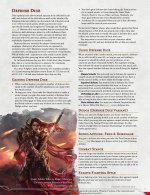I posted an analysis of this on Morrus' discord...
As presently written, suppose I'm a 15th level Duelist dual-wielding Scimitars (which effectively have the parrying property thanks to
Parry and Thrust), and that I have the Parrying Counter combat maneuver.
Under RAW, I can:
- Use my reaction at the end of my turn to, for 0* exertion, activate Parrying Counter against That Opponent (a creature I can see), for at minimum a d6 expertise die to my AC against them.
- with the scimitar in my left hand, once before my next turn gain an expertise die (d4) to my AC against a single melee attack made against me by a creature I can see.
- with the scimitar in my right hand, once before my next turn gain an expertise die (d4) to my AC against a single melee attack made against me by a creature I can see.
* assuming I still have
Panache uses left
Then, supposing that That Opponent makes a single melee attack against me, it would seem that the attack might be at:
[my AC] + 3 + 2 + 2 = [my AC] + 7 (range: 3 - 14 on a bell curve)
and that if That Opponent's attack misses, I would be entitled to:
- a melee weapon attack against it (from Parrying Counter)
- a melee weapon attack against it at the cost of 1 exertion (from Parry and Thrust)
Supposing that That Opponent makes two melee attacks against me and I used the parrying property on my two scimitars independently, one against each attack, it would be at:
[my AC] + 5 (range: 2 - 10 on a bell curve)
and I would be entitled to, if both attacks missed, three melee weapon attacks against it at the aggregate cost of 2 exertion.
Note that I am not factoring in the usual Expertise Die scaling effect
intentionally.
EXPERTISE DICE
Some class features or traits grant you an expertise die for an attack roll or saving throw, or in a specific skill or tool proficiency. When you make a d20 roll with which you have gained an expertise die, roll 1d4 and add the number rolled to the result of your check.
You can never roll more than one expertise die on the same roll. If another class feature or situation grants an expertise die of any size that applies to the same roll, you don’t gain another die; instead, the size of the largest expertise die increases for that check, from 1d4 to 1d6, or 1d6 to 1d8. For example, if you have gained two expertise dice, a 1d6 and 1d6, you now have a 1d8 expertise die. If you have a 1d8 expertise die on a check, further expertise dice have no effect.
The rules regarding the scaling of expertise dice are very clearly only expressed in the context of rolls with which you have gained expertise dice. Your AC is not a rolled value. Therefore, rules-as-written, the (almost certainly intended-to-apply-in-this-case-too) scaling of expertise dice does not apply, as the expertise dice are not modifying a
rolled value.
Now, I'm ... almost certain ... that it's not the intent of the abilities to potentially add (assuming that there is some mechanism by which the Parrying Counter expertise die can be bumped up to a d12 through synergistic bardic effects, and that the maximum value is obtained from all rolled dice used to modify AC against a single attack) 20 to a very lucky and well-coordinated duelist's AC.
I say "almost certain" because the degree of both coordination and luck that would need to transpire to bump AC by 20 using this combination of gambits strikes me as the kind of thing that would make for an exceptionally compelling narrative scene where the Human Duelist wielding two regular scimitars parries a Gundam wielding a blade the size of the Chrysler building (after which the Duelist gets three free attacks).



